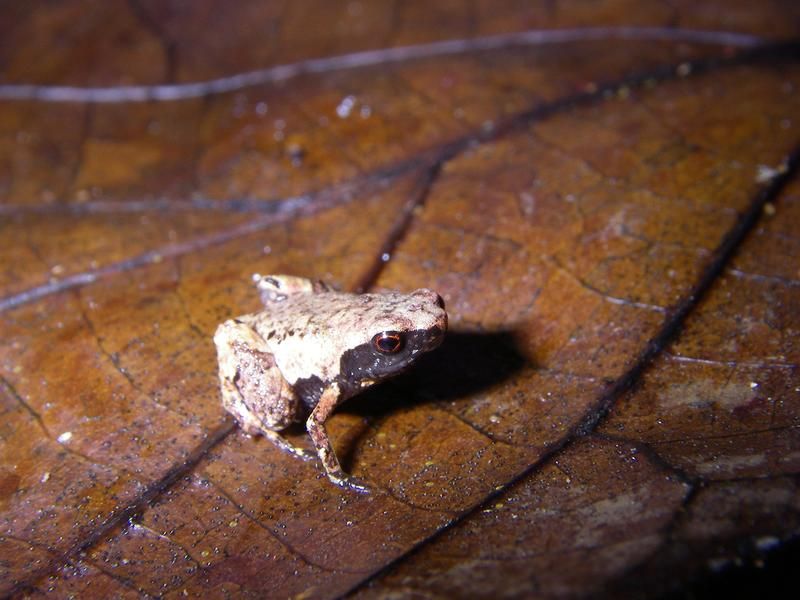Meet ‘Mini mum,’ ‘Mini scule’ and ‘Mini ature,’ Three New Frog Species Among the World’s Smallest
The newly discovered amphibians are all about the size of a thumbnail or smaller
/https://tf-cmsv2-smithsonianmag-media.s3.amazonaws.com/filer/98/32/983215be-9258-4b98-ab11-65c9afc310a5/file-20190328-139356-1es1hv5.jpg)
Three Madagascan frog species catalogued in a recently published PLoS ONE study boast a fittingly witty set of names. As lead author Mark Scherz, an evolutionary biologist at Munich’s Ludwig-Maximilians Universität, writes for the Conversation, the trio of tiny amphibians—the largest could comfortably sit on your thumbnail, while the smallest is roughly as long as a paper staple—constitute the newly minted “Mini” genus: In full, their scientific names are Mini mum, Mini scule and Mini ature.
According to National Geographic’s Michelle Z. Donahue, the world’s smallest known frog (and vertebrate) is Paedophryne amauensis, a Papua New Guinean native measuring an average of 7.7 millimeters long, or around the size of a housefly. Comparatively, Mini mum, the tiniest of the three newly discovered species, is around 8 to 10 millimeters long. Mini ature, measuring 14.9 millimeters, is roughly the length of a microSD card.
These are REALLY REALLY SMALL FROGS. But the crazy thing is that they are sister to the largest members of their family! Look at that size difference! #MiniFrogs #NewSpecies #science pic.twitter.com/zPIEPZGnrM
— Mark D. Scherz (@MarkScherz) March 27, 2019
Unsurprisingly, Scherz explains for the Conversation, locating such small creatures in vast natural spaces is a difficult task. Researchers must pay close attention to the sounds of the forest, tracking tiny frogs by their distinctive calls and pouncing before the hypersensitive amphibians detect a disturbance and leap away.
Successfully capturing specimens is simply the first hurdle. As Donahue notes, it’s hard enough distinguishing between normal-sized species on the basis of superficial differences. When the animals are Lilliputian-sized, identifying separate species becomes “virtually impossible.” Still, with the help of molecular and genetic analysis, as well as microCT scanning, Scherz and his colleagues were able to determine that they had chanced upon five entirely new types of frogs. (Rhombophryne proportionali, a 12-millimeter frog from northern Madagascar, and Anodonthyla eximia, a ground-dwelling species from eastern Madagascar, are also described in the PLoS ONE paper but have attracted less attention due to their lack of punny names.)
The three Mini members belong to the Microhylidae family of narrow-mouthed frogs. Found on all continents except Antarctica and Europe, according to a blog post published on Scherz’s personal website, the sizable family includes more than 650 recognized species, including 35 of the world’s 50 smallest frogs.
Mini mum, Mini scule and Mini ature all belong to the Madgascan-specific subfamily Cophylinae. Interestingly, Scherz observes, the trio appears to be genetically distinct from a similarly petite Cophylinae genus known as Stumpffia. Instead, Mini is more closely related to the genus Plethodontohyla, which counts the world’s largest microhylid frog, P. inguinalis, among its members.
As Eva-Marie Natzer of Germany’s Informationsdiest Wissenschaft points out, the most impressive aspect of the researchers’ findings is the realization that these tiny frog species evolved to their diminutive size independently of each other despite living in the same region. Donahue further explains that the Mini frogs likely adapted in order to take advantage of ecological niches inaccessible to larger creatures; the amphibians, for example, might now be better equipped to hunt down tiny prey such as ants and termites.

In a blog post, Scherz posits that miniaturization both forces animals to evolve certain new features and builds on existing features a species had prior to downsizing.
“When you get small, there seem to be physiological limitations that result in similar features” including larger eyes and big heads, Scherz writes, but “at the same time some things are lost or retained based on what you had before or based on luck of the draw.” R. proportionali offers a surprising “contrarian example” of this idea, as it retains the proportions of a larger frog despite measuring just 11 to 12.3 millimeters.
“You could sit [a Mini frog’s] brain on the top of a pin,” Scherz concludes to National Geographic's Donahue. “It’s amazing that they have all the same organs you or I have in our bodies, but in a package that can fit four times on your own thumbnail.”
/https://tf-cmsv2-smithsonianmag-media.s3.amazonaws.com/accounts/headshot/mellon.png)
/https://tf-cmsv2-smithsonianmag-media.s3.amazonaws.com/accounts/headshot/mellon.png)